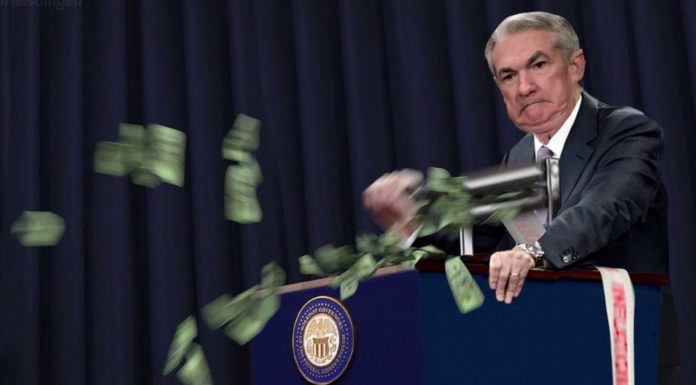(Money Metals Exchange) The S&P 500 broke out to a 5-week high yesterday. The rally comes on a rising tide of Federal Reserve liquidity coupled with on again, off again hopes for a stimulus deal in Washington.
More stimulus is definitely coming. The only question is how many trillions and whether they get dished out before or after the election.
At some point investors might begin to rethink whether trillions in additional deficit spending plus unlimited Quantitative Easing is as bullish for stocks as it ultimately will be for hard assets. A rising tide may lift all boats, but an undercurrent of inflation could send some investment vessels off course while giving others a big boost.
Investors must navigate through an unprecedented monetary environment. Never before has the nation’s central bank become so openly committed to depreciating the currency in coordination with politicians on Capitol Hill.
Past Federal Reserve chairmen at least publicly tried to urge members of Congress to be fiscally responsible. They warned of the dangers of running up excessive amounts of debt, even if they lacked the will to stop accommodating it with low interest rates.
But current Fed chair Jerome Powell is taking a categorically different approach – one that in just about any other time history would have been widely dismissed as bizarre or possibly even insane.
This week Powell lobbied politicians to spend more on fiscal stimulus. Despite already being on course to run up a record high budget deficit of over $3 trillion, Powell thinks it’s not big enough. He told lawmakers that there is now virtually no risk of spending too much, but that there is asymmetrically greater risk of spending too little.
Fox Business picked up on Powell’s big push.
[Edward Lawrence: This is the biggest push yet that I’ve seen from the Federal Reserve chairman to get more fiscal stimulus into the economy. He says that too little fiscal stimulus put into this economy would cause possibly a weaker recovery. He says, “You cannot overdo the package.” He says, “If it seems to be too large.” He says, “The risk is low, because that money would be helped anyway, in order to get this recovery moving.” The Federal Reserve will keep rates near zero until they believe they’re at maximum employment and the inflation is on track to run moderately above 2% for some time.]
If higher inflation and larger government deficits are the keys to a stronger economy, then what’s the point of having the government collect taxes at all?
According to Powell’s own logic, tax evaders as well as currency counterfeiters are doing us all a favor by stimulating the economy and contributing to the depreciation of the U.S. dollar.
Of course, to the elites who rule from Washington, it’s all about control. They want monopoly control over the counterfeiting of currency. They want to determine which parts of the economy get stimulated and which don’t.
A dangerous side effect of all the fiscal and monetary interventions into the economy is that market signals are no longer functioning properly. Fair value is no longer about what something is worth in a free market. It’s about what speculators think the Federal Reserve might buy next or Congress might rescue or subsidize next.
Everyone knows the bond market isn’t a real market when the largest buyer is a central bank set on controlling interest rates.
Some investors still think the stock market is a real market. But clearly, it’s not trading based solely on business fundamentals. It’s getting a massive, artificial valuation boost that just so happens to be tied to growth in money supply.
As artificial as these paper share markets may be, that doesn’t necessarily mean they are overvalued in terms of U.S. dollars. A case could be made that the S&P is actually undervalued – not yet fully pricing in the trillions in phony fiat set to be pumped into the banking system and consumers’ pockets so it can be capitalized on Wall Street.
An even stronger case could be made that precious metals markets are undervalued in terms of both Federal Reserve notes and most other asset classes on the planet. Silver in particular remains ridiculously cheap on a historical basis. Despite recently posting its sharpest rally in years, it has much, much further to run before it even challenges its former highs in terms of nominal dollars.
If the powers that be are actively trying to suppress silver and gold prices while at the same time trying to stimulate higher inflation rates, something will have to give. They cannot succeed at both objectives – not in the long run.
That should give long-term owners of bullion all the confidence they need to keep holding and keep exchanging their fiat money for hard money when opportunities present.



